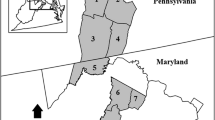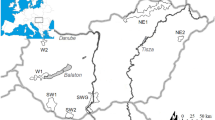Abstract
Population genetic parameters from different studies might be significantly influenced by differences in sample size, fraction of males and females, marker number, and sets of markers used, reducing the comparability between studies. This hypothesis was tested on a red deer population of 205 individuals with an estimated size of 1000 animals. Four tests were performed: (1) the population was subdivided into 10 populations each with 10 to 150 individuals and genotyped with 16 markers, (2) the total population was genotyped 10 times with different panels of microsatellite loci containing 2 to 14 markers, (3) a subset of 8 microsatellite loci was used to genotype the total population; markers of this subset were replaced one by one with a different marker set and genotyping results were compared to the results of the original subset and (4) the effect of sex was estimated. Additionally, 24 references from literature, including 256 European red deer populations, were analyzed. A median of 25 individuals per population was investigated in published studies using 11 microsatellite markers (5 to 22). Sixty-eight percent of possible study comparisons matched with less than 10% of microsatellite loci. Our results show that the factors investigated, except for the factor gender, lead to significant deviations in the population genetic results, especially with sample sizes below 30, with less than 6 to 8 microsatellite markers and with the use of different panels of microsatellite loci. This is also true with respect to population genetic structure and the use of Bayesian methods. Therefore, populations from different studies should be compared with each other with caution.






Similar content being viewed by others
References
Bana NA, Nyira A, Nagy J, Frank K, Nagy T, Steger V, Schiller M, Lakatos P, Sugar L, Horn P, Barta E, Orosz L (2018) The red deer Cervus elaphus genome CerEla1.0: sequencing, annotating, genes, and chromosomes. Mol Gen Genomics 293:665–684
Dellicour S, Frantz AC, Colyn M, Bertouille S, Chaumont F, Flamand MC (2011) Population structure and genetic diversity of red deer (Cervus elaphus) in forest fragments in North-Western France. Conserv Genet 12:1287–1297
Fickel J, Bubliy OA, Stache A, Noventa T, Jirsa A, Heurich M (2012) Crossing the border? Structure of the red deer (Cervus elaphus) population from the Bavarian–Bohemian forest ecosystem. Mamm Biol 77:211–220
Frantz AC, Hamann JL, Klein F (2008) Fine-scale genetic structure of red deer (Cervus elaphus) in a French temperate forest. Eur J Wildl Res 54:44–52
Frantz AC, Bertoille S, Eloy MC, Licoppe A, Chaumont F, Flamand MC (2012) Comparative landscape genetic analyses show a Belgian motorway to be a gene flow barrier for red deer (Cervus elaphus), but not wild boars (Sus scrofa). Mol Ecol 21:3445–3457
Galarza JA, Sánchez-Fernández B, Fandos P, Soriguer R (2015) The genetic landscape of the Iberian red deer (Cervus elaphus hispanicus) after 30 years of big-game hunting in southern Spain. J Wildl Manag 79:500–504
Galarza JA, Sánchez-Fernández B, Fandos P, Soriguer R (2017) Intensive management and natural genetic variation in red deer (Cervus elaphus). J Hered 108:496–504
Hajji GM, Charfi-Cheikrouha F, Lorenzini R, Vigne J-D, Hartl GB, Zachos FE (2008) Phylogeography and founder effect of the endangered Corsican red deer (Cervus elaphus corsicanus). Biodivers Conserv 17:659–673
Hmwe SS, Zachos E, Eckert I, Lorenzini R, Fico R, Hartl GB (2006a) Conservation genetics of the endangered red deer from Sardinia and Mesola with further remarks on the phylogeography of Cervus elaphus corsicanus. Biol J Linn Soc 88:691–670
Hmwe SS, Zachos FE, Sale JB, Rose HR, Hartl GB (2006b) Genetic variability and differentiation in red deer (Cervus elaphus) from Scotland and England. J Zool 270:479–487
Höglund J, Cortazar-Chinarro M, Jarnemo A, Thulin C-G (2013) Genetic variation and structure in Scandinavian red deer (Cervuselaphus): influence of ancestry, past hunting, and restoration management. Biol J Linn Soc 109:43–53
Hoffmann GS, Johannesen J, Griebeler EM (2016) Population dynamics of a natural red deer population over 200 years detected via substantial changes of genetic variation. Ecol Evol 6:3146–3153
Jombart T, Devillard S, Balloux F (2010) Discriminant analysis of principal components: a new method for the analysis of genetically structured populations. BMC Genet 11:94
Kalinowski ST, Taper ML, Marshall TC (2007) Revising how the computer program cervus accommodates genotyping error increases success in paternity assignment: Cervus likelihood Model. Mol Ecol 16:1099–1106
Kinser A, Herzog S (2008) Genetisches Monitoring von Rotwild in Niedersachsen—Ergebnisse einer Langzeitstudie. Deutsche Wildtierstiftung:1–27
Koskinen MT, Hirvonen H, Landry P-A, Primmer CR (2004) The benefits of increasing the number of microsatellites utilized in genetic population studies: an empirical perspective. Hereditas 141:61–67
Krojerová-Prokešová J, Barančeková M, Koubek P (2015) Admixture of Eastern and Western European red deer lineages as a result of postglacial recolonization of the Czech Republic (Central Europe). J Hered 106:375–385
Kuehn R, Anastassiadis C, Pirchner F (1996) Transfer of bovine microsatellites to the cervine (Cervus elaphus). Anim Genet 27:199–201
Kuehn R, Schroeder W, Pirchner F, Rottmann O (2003) Genetic diversity, gene flow and drift in Bavarian red deer populations (Cervus elaphus). Concervation Genetics 4:157–166
Kuehn R (2004) Genetic roots of the red deer (Cervus elaphus) population in eastern Switzerland. J Hered 95:136–143
xNiedziałkowska M, Jędrzejewska B, Wójcik JM, Goodman SJ (2012) Genetic structure of red deer population in northeastern Poland in relation to the history of human interventions. J Wildl Manag 76:1264–1276
Nielsen EK, Olesen CR, Pertoldi C, Gravlund P, Barker JSF, Mucci N, Randi E, Loeschcke V (2008) Genetic structure of the Danish red deer (Cervus elaphus). Biol J Linn Soc 95:688–701
Peakall R, Smouse PE (2012) GenAlEx 6.5: genetic analysis in Excel. Population genetic software for teaching and research-an update. Bioinformatics 28:2537–2539
Perez-Espona S, Perez-Barberia FJ, Mcleodi JE, Jiggins CD, Gordon IJ, Pemberton JM (2008) Landscape features affect gene flow of Scottish Highland red deer (Cervus elaphus). Mol Ecol 17:981–996
Perez-Gonzales J, Frantz AC, Torres-Porras J, Castillo L, Carranza J (2012) Population structure, habitat features and genetic structure of managed red deer populations. Eur J Wildl Res 58:933–943
Poetsch M, Seefeldt S, Maschke M, Lignitz E (2001) Analysis of microsatellite polymorphism in red deer, roe deer, and fallow deer—possible employment in forensic applications. Forensic Sci Int 116:1–8
Puckett EE (2017) Variability in total project and per sample genotyping costs under varying study designs including with microsatellites or SNPs to answer conservation genetic questions. Conserv Genet Resour 9:289–304
Queiros J, Vicente J, Boadella M, Gortazar C, Alves PC (2014) The impact of management practices and past demographic history on the genetic diversity of red deer (Cephalus elaphus): an assessment of population and individual fitness. Biol J Linn Soc 111:209–233
Raymond M, Rousset F (1995) GENEPOP (Version 1.2): Population genetics software for exact tests and Ecumenicism. J Hered 86:248–249
Rice WR (1989) Analysing tables of statistical tests. Evolution 43:223–225
Roed KH, Midthjell L (1998) Microsatellites in reindeer, Ragnifer tarandus, and their use in other cervids. Mol Ecol 7:1773–1776
Schlötterer C (2004) Opinion: The evolution of molecular markers — just a matter of fashion? Nature Rev Genet 5: 63–69
Slate J, Coltman DW, Goodman SJ, MacLean I, Pemberton JM, Williams JL (1998) Bovine microsatellite loci are highly conserved in red deer (Cervus elaphus), sika deer (Cervus nippon) and Soay sheep (Ovis aries). Anim Genet 29:307–315
Sprem N, Frantz AC, Cubric-Curik V, Safner T, Curik I (2013) Influence of habitat fragmentation on population structure of red deer in Croatia. Mamm Biol 78:290–295
van Oosterhout C, Hutchinson WF, Wills DPM, Shipley P (2004) Micro-checker: software for identifying and correcting genotyping errors in microsatellite data. Mol Ecol Notes 4: 535–538
Weir BS, Cockerham CC (1984) Estimating F-statistics for the analysis of population structure. Evolution 38:1358–1370
Willems H, Hecht W, Reiner G (2016) Temporal variation of the genetic diversity of a German red deer population between 1960 and 2012. Eur J Wildl Res 62:277–284
Zachos F, Hartl GB, Apollonio M, Reutershan T (2003) On the phylogeographic origin of the Corsian red deer (Cervus elaphus corsicanus): evidence from microsatellites and mitochondrial DNA. Mamm Biol 68:284–298
Zachos FE, Althoff C, Steynitz Y, Eckert I, Hartl GB (2007) Genetic analysis of an isolated red deer (Cervus elaphus) population showing signs of inbreeding depression. Eur J Wildl Res 53:61–67
Zachos FE, Hartl GB (2011) Phylogeography, population genetics and conservation of the European red deer Cervus elaphus. Mammal Rev 41:138–150
Zachos F, Frantz AC, Kuehn R, Bertouille S, Colyn M, Niedziałkowska M, Pérez-González J, Skog A, Sprem N, Flamand MC (2016) Genetic structure and effective population sizes in European Red Deer (Cervus elaphus) at a continental scale: insights from microsatellite DNA. J Hered 107:318–326
Acknowledgments
The authors greatly appreciate the technical assistance of Mrs. Bettina Hopf and the samples and indispensable information about the red deer area provided by Dr. Norbert Teuwsen.
Author information
Authors and Affiliations
Corresponding author
Ethics declarations
Conflict of interest
The authors declare that they have no competing interests.
Additional information
Publisher’s note
Springer Nature remains neutral with regard to jurisdictional claims in published maps and institutional affiliations.
Electronic supplementary material
ESM 1
(DOCX 31 kb)
Rights and permissions
About this article
Cite this article
Reiner, G., Lang, M. & Willems, H. Impact of different panels of microsatellite loci, different numbers of loci, sample sizes, and gender ratios on population genetic results in red deer. Eur J Wildl Res 65, 25 (2019). https://doi.org/10.1007/s10344-019-1262-x
Received:
Revised:
Accepted:
Published:
DOI: https://doi.org/10.1007/s10344-019-1262-x




